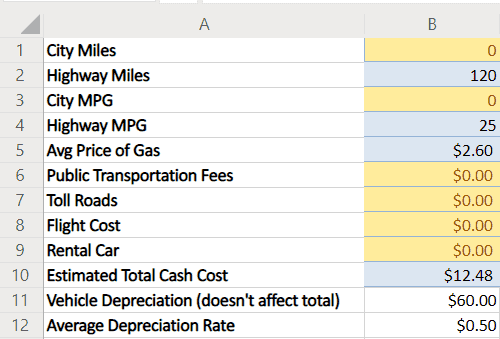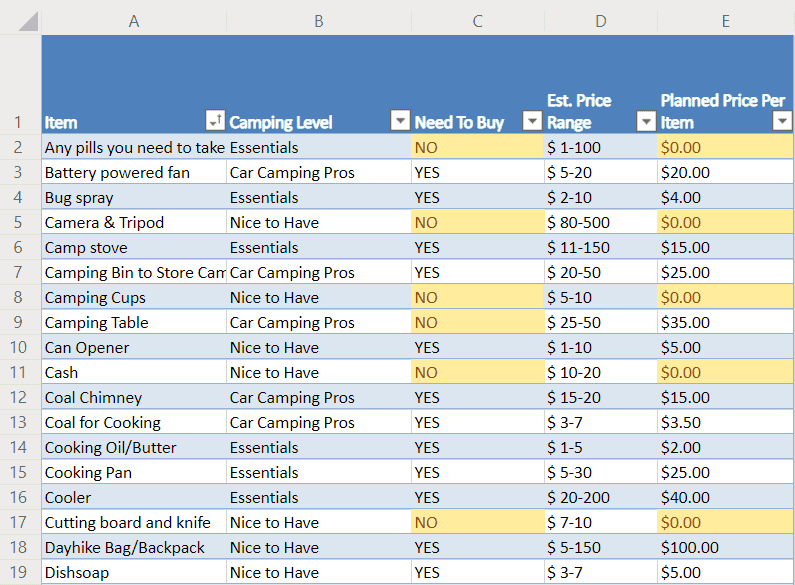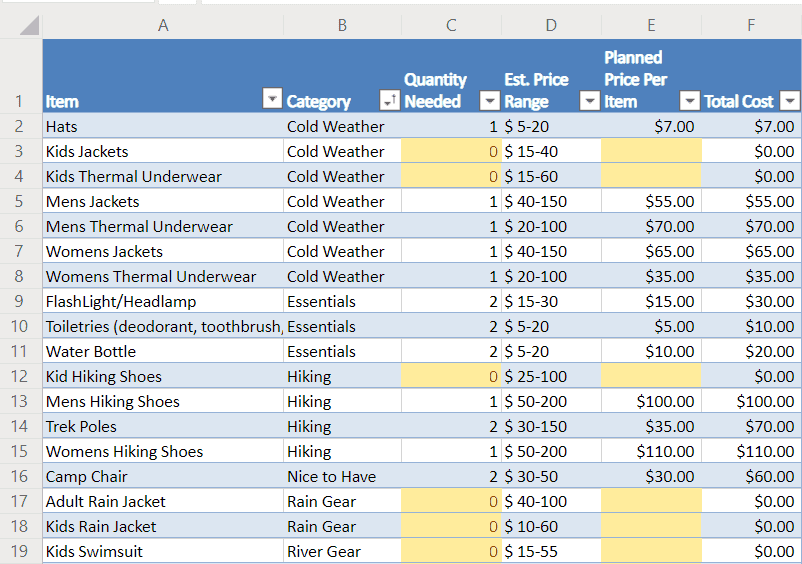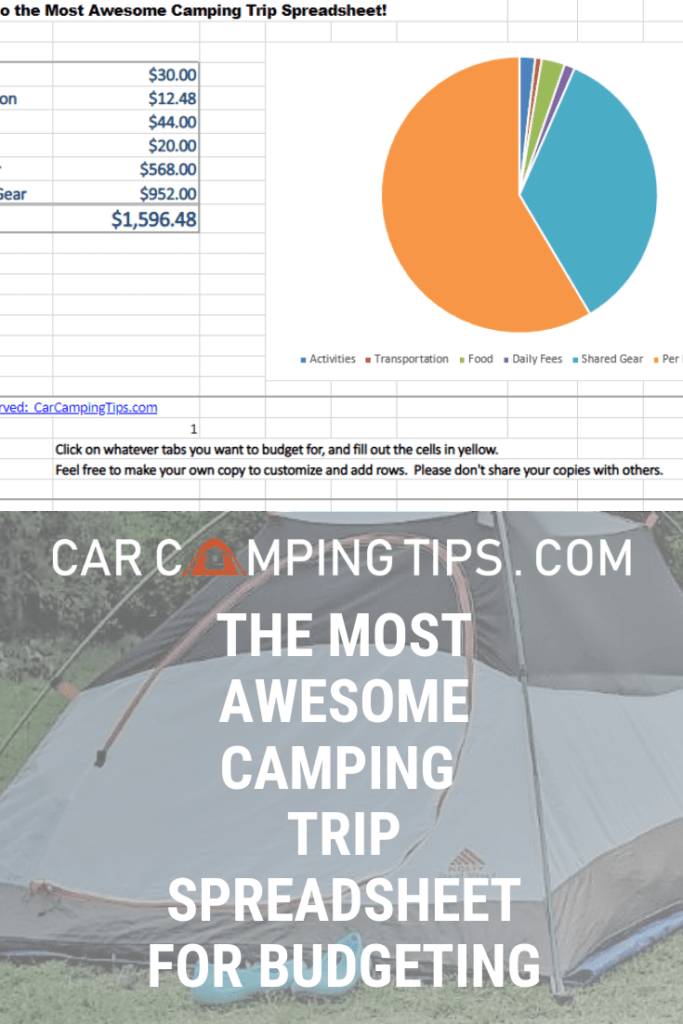I love spreadsheets. In fact, I’ve made several of my life’s important decisions with spreadsheets to weigh the pros and cons before moving forward with a particular path. Although going camping isn’t exactly a life decision, let’s face it–camping can be quite expensive, initially. I didn’t know how expensive until I put together this spreadsheet. This will help you plan and figure out your costs so you can budget accordingly.
I’m giving away this spreadsheet for FREE. No questions asked, no fine print.
If however, you enjoy this spreadsheet or found it useful, I’d be honored by whatever amount you think it’s worth. You can send a small donation here if you’d like. (Thanks very much by the way)
By the way, as an Amazon Associate, I earn when buying qualified products through links on my site.
Where can you find a good camping trip spreadsheet template? Click Here For The Most Awesome Camping Trip Spreadsheet. This spreadsheet allows you to calculate the total cost of a camping trip, including activities, transportation, food, daily fees, shared gear, and per person gear.
To see the spreadsheet in action and to get an idea of how much camping really costs, check out my YouTube video:
My goal is to make a comprehensive and flexible spreadsheet that can more accurately plan out the costs of camping. It’s geared towards car camping, but it’s flexible enough to include gear for backpackers or for large camping groups such as for scouts.
As with any spreadsheet, there is some learning curve and I’ll use the rest of this post to explain how to use the spreadsheet as well as some ideas on how to cut costs.
Instructions For Using The Most Awesome Camping Trip Spreadsheet
Summary Tab

The summary tab takes in all the other tabs information and collates them so you can see the grand total for all the categories. This amount is roughly how much we’ve spent on camping gear, but is probably undershooting it because there are undoubtedly other things that I’ve forgotten and that I hope to add to the list over time.
In any case, the image shows $1596.48 as the total, and this number is assuming that we are having to purchase many of the essentials. The 1st trip will be the most expensive, but after that, we will need very little new gear as time goes on.
Activities

Many destinations have much more to do than just sleeping in a tent. Many have rivers, caves, and countless other attractions that all cost money.
This activities tab will help you plan out the costs for all those activities.
Transportation

Food

Food is probably one of the most difficult categories to calculate–but buying food specifically for camping can get very expensive, especially for multiple days, so it’s probably best to guess high. These numbers are assuming we were able to use bulk groceries that we buy on a regular basis, such as eggs, and bread.
Backpackers have a much more complicated job since dehydrated food can be more expensive, and weight is another factor besides cost.
Feel free to add rows specific to the meals you want to prepare if you want to be more exact in your calculations.
Daily Fees

The daily park fees can add up, so it’s very helpful to see how many days you will need to consider for your fees.
You can add additional rows if you are planning on spending time at multiple parks with different prices. Sometimes parks allow kids for free, and others do not, so those will all affect your totals.
The campsite reservation fee is a little weird, since it doesn’t directly rely on how many people you have. If you need to reserve two campsites, you can put 2 instead of NA and it will calculate accordingly.
Shared Gear

The shared gear tab is where you can put gear that will be used by your whole group and isn’t specific to a person.
The Camping Level column is to help you decide between gear that is essential, gear that is nice to have, and gear that is for serious car campers who plan on doing lots of camping. For example, a coal chimney is not a necessity for an overnight stay, but if you are cooking outdoors a lot, it can be very handy and makes igniting your coals much easier. Thus, a coal chimney fits into the Car Camping Pros category.
The Need to Buy column is there if you 1. already have the gear 2. want to skip buying the gear because you don’t need it. 3. you are deciding to bring an alternative. Once you buy or decide on an alternative, you can change the dropdown from YES to NO, and it will subtract it from the total.
The Est. Price Range column is to assist you in knowing what to expect for prices. It’s difficult to assess, because the price range can be very wide, or, you may find cheaper alternatives at thrift stores or on Craigslist/Offerup/Letgo. (or even the side of the road!)
The Planned Price Per Item is how much you are planning to spend on that particular item. With Amazon or Walmart.com, it’s easy to pick the exact brand and model of your gear.
You can save a lot of money by not going out and buying everything on a checklist–rather, just focus on the camping essentials so you and your family can have a good time. You’ll learn, over time, what things you want and can’t live without, personally.
This list is in flux–there’s a lot to add that I probably haven’t accounted for and I will try to keep that updated.
Per Person Gear

Gear for every camping occasion for each individual
The Per Person Gear tab is for calculating the cost of items that are specific to each person. You might be able to get away with separating each category into kids/adults, but sometimes you will need to be specific to each person if there are direct needs for an individual. Feel free to add rows for specific items.
The Category column is there to help separate your different occasions. If you are planning on floating down a river during one of your days camping, then you may need to include budgeting for river gear. If rain is forecasted (or even if it’s not), you may want to bring rain gear, etc.
The Quantity Needed column is there to help you group multiple necessary purchases, such as multiple sleeping bags of the same size, or trek poles, etc.
Again, the Est. Price Range gives you a ballpark of what to expect to spend on each item.
Also once again, the Planned Price Per Item is the actual price you are planning on spending on an item which you can find online on Amazon or whatever other retailer you prefer.
Ways To Save
The price tag for your first camping trip will inevitably be the highest. Without the gear purchases (since we have all we need already), our trip would have cost around $105. The biggest way to save is to save on gear.
- Thrift stores are gold mines for camping gear. You can find almost all the kitchen stuff you will need. Thrift kitchen gear is ideal for car camping because you are only using this gear for camping, so you don’t have to worry about getting the nicest equipment
- Bring it from home. Many sleeping items become optional if you bring enough blankets and supplies from home. You don’t have to purchase camping pillows or pads if you have other alternatives you can bring from home. If you are planning on camping a lot, it’s a good idea to invest in gear specific to camping so you don’t ruin your stuff from your house, but for starting out, this works perfectly well
- Craigslist, Offerup, Letgo, eBay (to name a few) are great resources for finding used gear. You are more likely to find high quality gear that hasn’t been picked over in a thrift store by buying directly from others.
- Find it for free! I know this doesn’t sound reasonable… but our city does a bulk pickup every year and people will put out things they want hauled away. We have never bought a camp chair, and we have 4 of them.
- Do without. Sleeping in a huge 8-man tent will not be much more comfortable than sleeping in a 4-man (if there are just two people). One part of the fun of camping is to do without all the luxuries of home, which makes you appreciate your bed at home, but also helps you connect with nature.
- Avoid Backpacking Gear. There is a huge premium for backpacking camping gear. Online retailers often don’t distinguish and everything falls under the category of “camping.” Backpacking gear, especially ultralight gear is much more expensive, and isn’t what a car camper needs. Heavy, cheaper gear will do just fine since you are not going to be far from your car.
Hope you enjoy the spreadsheet and that it’s useful to you!

